
by Barry E. DiGregorio Monday, March 2, 2015
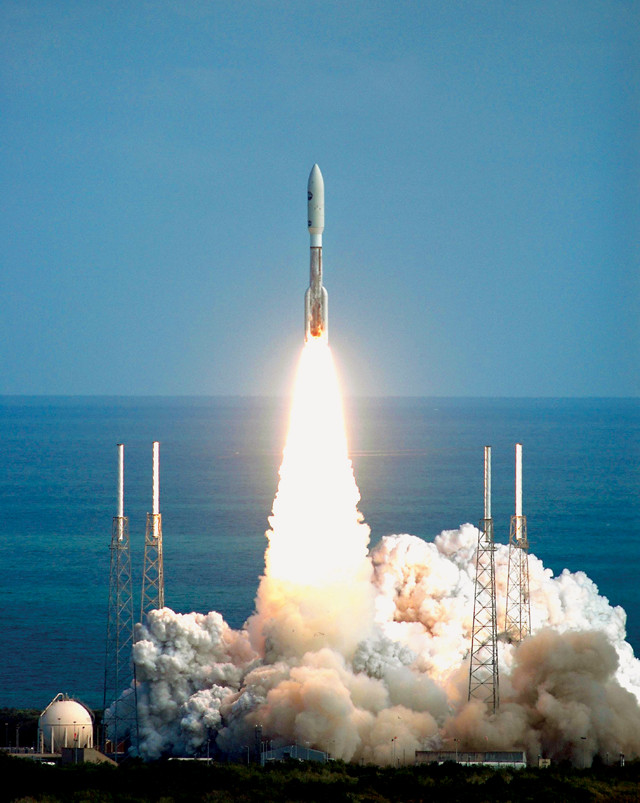
New Horizons was launched aboard an Atlas V rocket from Kennedy Space Center at Cape Canaveral, Fla., on Jan. 19, 2006. Credit: NASA.
Last year was an exciting one for space exploration. On Oct. 19, spacecraft at Mars got a close-up of Comet Siding Spring as it passed within about 132,000 kilometers of the red planet (less than half the distance between Earth and the moon). And on Nov. 12, the European Space Agency’s historic Rosetta mission set the Philae lander down on Comet 67P. This year promises yet another historic mission as NASA’s New Horizons spacecraft visits the outer solar system, conducting the first flybys of Pluto and the even-more-distant Kuiper Belt.
On July 14, the New Horizons spacecraft, which was launched in 2006, will fly within 10,000 kilometers of the surface of Pluto, about 7.5 billion kilometers from Earth. Because of this enormous distance, Pluto has remained largely a mystery since its discovery in 1930 by amateur astronomer Clyde Tombaugh at the Lowell Observatory in Flagstaff, Ariz. Even the powerful Hubble Space Telescope has not glimpsed its surface in any detail. However, by using long-exposure photography with the planetary cameras on Hubble, combined with spectrographic analysis, astronomers have managed to piece together some of the details of the distant, icy body, which was formally reclassified as a dwarf planet in 2006 by the International Astronomical Union.
Pluto has five known moons: Charon, Styx, Nix, Kerberos and Hydra. It has a thin but complex atmosphere that is 150 times less dense than Earth’s and composed of nitrogen, carbon monoxide and methane; Pluto also experiences seasonal cycles as it revolves around the sun roughly once every 248 Earth years. Multiple types of exotic ices cover the surface, which has been observed to change over time. The icy body may even have an internal ocean.
Now, nearing its first destination after nearly a decade in space, New Horizons is primed to learn even more about this enigmatic object that was once considered the ninth planet of the solar system.
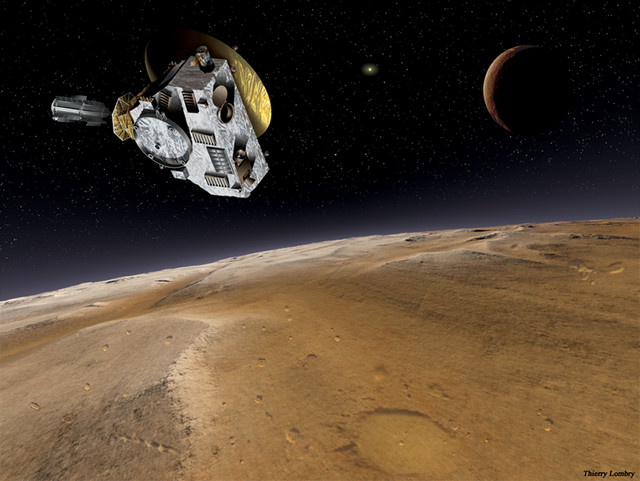
New Horizons, illustrated here, is the fastest spacecraft ever launched, reaching lunar-orbit distance just nine hours after launch and passing Jupiter just 13 months later. Credit: NASA/Thierry Lombry.
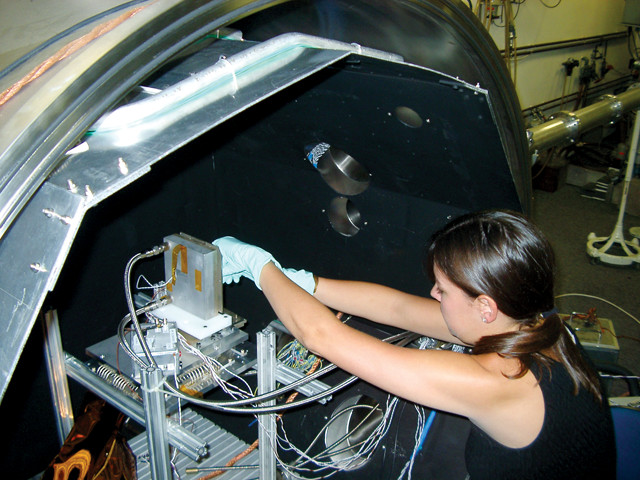
The Venetia Burney Student Dust Counter was designed and built by students at the University of Colorado at Boulder. The instrument is named for the 11-year-old British girl who, in 1930, suggested the planet discovered by Clyde Tombaugh be named Pluto. Credit: LASP.
Launched on Jan. 19, 2006, the New Horizons spacecraft is about the size and shape of a baby grand piano and weighs almost half a metric ton. The spacecraft will be traveling at 14 kilometers per second during its close encounter with Pluto, when it will use a suite of powerful remote sensing instruments, including imaging spectrometers and in situ plasma and dust detectors. This scientific payload will allow researchers to study the surfaces of all six known objects in the Pluto system, as well as search for new ones. The instruments will also peer into Pluto’s atmosphere, search for an atmosphere around Charon, and study the local interplanetary environment; they may also provide information on the interiors and origins of the objects in the Pluto system.
Communication with and transmission of data back to Earth from New Horizons will take four and a half hours at the speed of light. Because the irradiance of sunlight received at the distance of Pluto is just one one-thousandth of that received in Earth’s orbit, the spacecraft is powered by a thermoelectric generator that uses the thermal energy created by the decay of plutonium-238 to produce electrical energy.
Once the primary mission is complete, project scientists hope to have the spacecraft visit a few other large icy objects — thought to be similar to Pluto — that lie in the Kuiper Belt. This belt comprises a vast ring of primordial debris beyond the orbit of Neptune and is left over from the formation of the solar system. After its Kuiper Belt encounter, New Horizons will continue traveling out into interstellar space, like the Pioneer and Voyager missions launched in the 1970s.
“We’re all looking forward to the remarkable discoveries New Horizons will provide on the properties of Pluto and its moons, but the scientific implications of the results will go well beyond what we’ll learn specifically about the Pluto system,” says New Horizons project scientist Hal Weaver of the Johns Hopkins University Applied Physics Laboratory. “The New Horizons mission will provide the first in situ investigation of objects in the Kuiper Belt, making it a unique voyage of discovery,” he says. “It’s unlikely we’ll see a similar venture into the solar system’s ‘third zone’ — the region beyond Neptune — for at least [another] two decades, if not longer.”
Some of New Horizons’ instruments will turn on when it approaches Pluto, but others operated on the outbound voyage, making observations of Jupiter and Saturn and measuring the solar wind.
A successful encounter with Jupiter in early 2007 returned a treasure trove of important scientific results. “We provided the most detailed observations ever of Jupiter’s newly formed Little Red Spot, the best look ever at Io’s spectacular volcanoes, discovered lightning in Jupiter’s polar regions, found interesting structures in Jupiter’s faint rings, saw upwelling of fresh ammonia clouds in Jupiter’s atmosphere, and made by far the best sampling of the plasma in Jupiter’s long magnetotail,” Weaver says.
Although New Horizons won’t reach its closest approach to Pluto until July 14, mission scientists began making observations of the former planet on Jan. 15, in hopes of uncovering similarly exciting results.
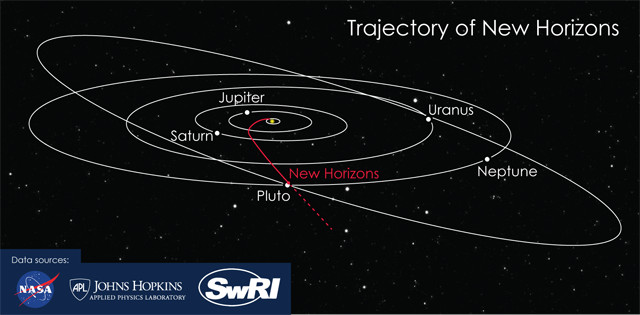
NASA's New Horizons spacecraft, the first mission to Pluto and the Kuiper Belt, is due to reach the Pluto system on July 14, 2015. After that, it will fly by Kuiper Belt Objects (an example of which is illustrated below), the most distant bodies in the solar system. Credit: Kathleen Cantner, AGI, after NASA.
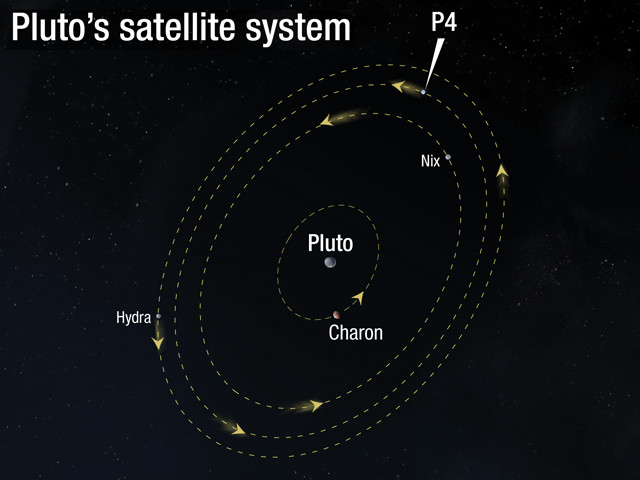
Illustration of the orbits of Pluto's satellites highlighting the newly discovered fourth moon, P4 (now named Kerberos), which was discovered in 2011. A fifth moon, discovered in 2012, was named Styx. Credit: NASA, ESA, and A. Feild (STScI).
Following its flyby of the Pluto system and the Kuiper Belt, New Horizons will start searching for connections between this mysterious region and the rest of the solar system. Questions include, for example: How do New Horizons’ observations impact our understanding of comets, many of which originate in the Kuiper Belt? Will our studies of Pluto’s “mini solar system” reveal more clearly how planet formation works? How does Pluto compare in detail to other similarly sized or icy bodies, including Triton, Neptune’s largest moon; Titan, Saturn’s largest satellite; and Ceres, the solar system’s largest asteroid? Did they all form in the same region of the early solar system, or closer to or farther from the sun? Researchers also want to know how Pluto’s smaller satellites compare to the Jovian Trojans — asteroids that orbit the sun on the same path as Jupiter — and to small Kuiper Belt Objects with orbits similar to Pluto’s. Astronomers don’t currently think Trojans resemble the asteroids from the main belt between Mars and Jupiter, nor the Kuiper Belt family of objects from the icier, outer regions near Pluto. New Horizons will provide much needed answers on how the different materials in the early solar nebula formed at various distances from the sun.
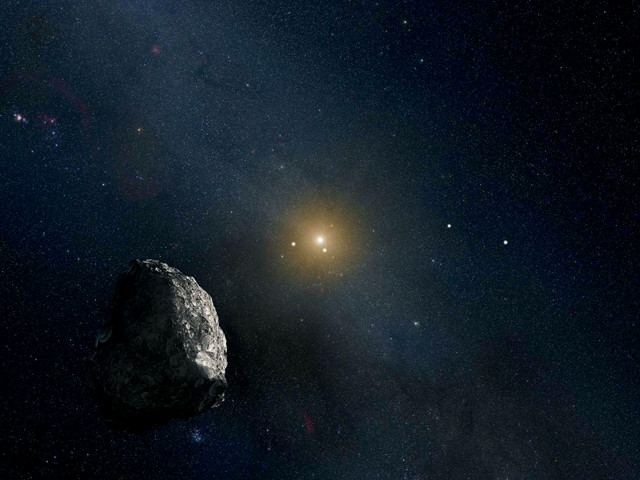
Artist's impression of a Kuiper Belt Object (KBO), located on the outer rim of our solar system about 7 billion kilometers from the sun. A Hubble Space Telescope survey identified three KBOs that are potentially reachable by NASA's New Horizons spacecraft after it passes by Pluto in mid-2015. Credit: NASA, ESA, and G. Bacon (STScI).
“he mission is not without its risks. As New Horizons nears Pluto, the most perilous part of the remaining portion of the mission will be the crossing of P"uto’s orbital plane (the plane containing Pluto and its satellites), because that is when the spacecraft risks encountering millimeter-sized dust particles. The New Horizons spacecraft is moving so fast that even a small particle could blast a hole in some critical component, ending the mission.
“Fortunately, we think this is extremely unlikely,” Weaver says, adding that the project team estimates, at worst, a 0.1 percent chance of this happening. “Nevertheless, we’re taking this risk seriously and will be making sensitive observations during the approach to Pluto that should provide us with a better estimate. If we see something worrisome, we can turn the New Horizons spacecraft so that its antenna will shield critical areas from impinging dust [a common technique used for spacecraft visiting Saturn] and even tweak the trajectory to reduce the hazard. But it’s much more likely that these mitigations won’t be necessary.”
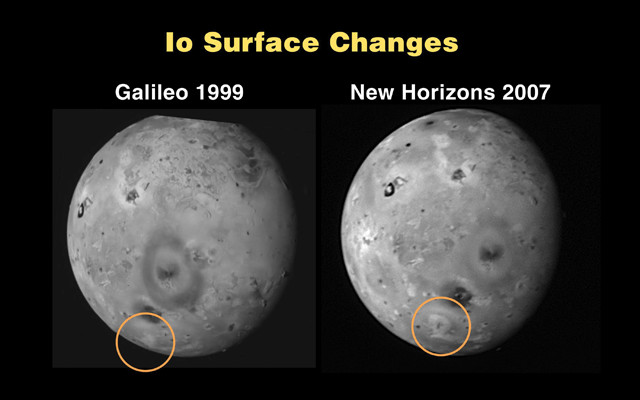
New Horizons flew past Jupiter in early 2007, gleaning new scientific data about the Jovian moon Io, and using the planet's gravity to slingshot itself toward Pluto, which shaved as much as five years off the trip. Credit: NASA.
Dale Cruikshank, an astronomer at NASA Ames Research Center and a member of the New Horizons science team who has been involved in planning the mission for 20 years, has jokingly said that one of the biggest surprises for him would be finding woolly mammoths on Pluto’s surface. Cruikshank’s expertise is in determining the composition of planetary surfaces through the use of infrared spectroscopy. In 1976, using Earth-based telescopic measurements of Pluto, he co-discovered methane ice on the surface, and since then has been involved in the discovery of the other types of ices known to exist there, including nitrogen, carbon monoxide and ethane.
Coincident with the New Horizons mission, Cruikshank is looking for complex organic molecules in his lab that might cause a similar coloration on Pluto to understand how organic molecules form under such cold conditions so far from the sun. Cruikshank is irradiating different ice mixtures with compositions similar to Pluto’s with ultraviolet and other wavelengths of light that simulate the sun and cosmic rays. “This irradiation produces a refractory solid having colors similar to those of Pluto and a composition consisting of complex molecules of various kinds,” Cruikshank says.
“One major goal of this work is to identify the composition of the non-ice component(s) of the surfaces of Pluto and its satellites,” he says. From New Horizons, “I expect to find local concentrations of the ices we have already identified from telescopic observations, as well as evidence for other kinds of materials (ices and non-ice material) that are locally concentrated but have so far been undetectable from Earth.”
Chandra Wickramasinghe, director of the Buckingham Center for Astrobiology at Buckingham University in England, says he hopes the mission will offer significant revelations with regard to how life could potentially be transported from one planet to another, or even from one solar system to another.
“The New Horizons mission to Pluto will have the chance of probing a frozen waste of the outer solar system, which I think was the birthplace of the comets,” says Wickramasinghe, who is not directly involved with the mission. “Because comets, in my view, are the incubators and transmitters of microbial life in the galaxy, I eagerly await new spectroscopic data that can be interpreted as evidence of life.”
Researchers will also be analyzing how the solar wind interacts with Pluto to study the atmosphere’s escape rate, which is thought to be similar to the rate at which cometary gases bleed into space. This extremely fast leakage, in which the thermal energy of typical molecules in the upper atmosphere is sufficient to escape the planet’s gravity, could be similar to the rapid loss of hydrogen from Mars early in our solar system’s history.
“Solar wind observation will provide the key measurements to determine the total atmospheric escape rate from Pluto as well as to discover the overall solar wind-Pluto interaction, and the existence, or not, of a planetary bow shock,” says David McComas of the Southwest Research Institute, who is principal investigator for the Solar Wind Around Pluto (SWAP) instrument on New Horizons.
And what else does McComas think New Horizons might find? “I never speculate about surprises, but experience has shown that the physical universe is far more complex and surprising than we ever envision before we go somewhere new and make the measurements.”
© 2008-2021. All rights reserved. Any copying, redistribution or retransmission of any of the contents of this service without the expressed written permission of the American Geosciences Institute is expressly prohibited. Click here for all copyright requests.